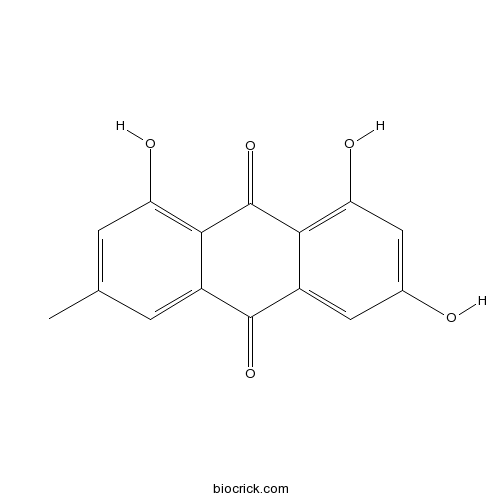A trihydroxyanthraquinone that is 9,10-anthraquinone which is substituted by hydroxy groups at positions 1, 3, and 8 and by a methyl group at position 6. It is present in the roots and barks of numerous plants (particularly rhubarb and buckthorn), moulds, and lichens. It is an active ingredient of various Chinese herbs.
InChI=1S/C15H10O5/c1-6-2-8-12(10(17)3-6)15(20)13-9(14(8)19)4-7(16)5-11(13)18/h2-5,16-18H,1H3
Emodin, a natural anthraquinone derivative isolated from Rheum palmatum L., exhibits anti-cancer effect on several human cancers such as liver cancers and lung cancers, treatment with 50 microM emodin resulted in a pronounced release of cytochrome c, activation of caspase-2, -3, and -9, and apoptosis in human lung adenocarcinoma A549 cells.[1]
Emodin has a strong antimicrobial activity and anti-virus effect , can inhibit HBV DNA replication and HBsAg secretion in HepG2.2.15 cells, may be a new modality to treat hepatitis B infection. [2]
Emodin significantly inhibits 12-O-tetradecanoylphorbol-13-acetate (TPA)-induced in vitro invasion of human cancer cells including HSC5 and MDA-MB-231 cells, and inhibits the invasiveness of human cancer cells by suppressing MMP-9 expression through inhibiting AP-1 and NF-kappaB signaling pathways.[3]
[1] Su Y T, Chang H L, Shyue S K, et al. Biochem Pharmacol, 2005, 70(2):229–241.
[2] Shuangsuo D, Zhengguo Z, Yunru C, et al. 2006, 12(9):302-6.
[3] Huang Q, Shen H M, Ong C N. Biochem Pharmacol, 2004, 68(2):361-71.
[4] Shi Y B, Shi Y P, Yang Y B, et al. Chromatographia, 2007, 65(9-10):601-606.



